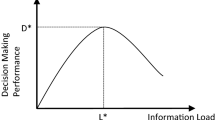Abstract
An exploratory approach was taken to examine personnel psychologists' use of sources of information when making a decision regarding candidates' fit to managerial positions. The main focus was on the process, based on actual information used to make real-life decisions about real-life candidates. Different types of information, available to the psychologists were used to predict their actual final decision regarding a sample of 434 managerial candidates. Results suggest a preference to indices of cognitive skills in making decisions about candidates. It seems that even when other non-cognitive indices were used, they were “tainted” by the cognitive indices, suggesting a halo effect. Implications for practice and further research are discussed.
Similar content being viewed by others
REFERENCES
Barrick, M. R., & Mount, M. K. (1991). The big five personality dimensions and job performance. Personnel Psychology, 44(1), 1-26.
Bliesener, T. (1996). Methodological moderators in validating biographical data in per-sonnel selection. Journal of Occupational and Organizational Psychology, 69(1), 107-120.
Carretta, T. R., & Ree, M. J. (2000). General and specific cognitive and psychomotor abilities in personnel selection: The prediction of training and job performance. International Journal of Selection and Assessment, 8(4), 227-236.
Dalen, L. H., Stanton, N. A., & Roberts, A. D. (2001). Faking personality questionnaires in personnel selection. Journal of Management Development, 20(8), 729-742.
Dawda, D., & Hart, S. (2000). Assessing Emotional Intelligence. Personality and Individual Differences, 28(4), 797-812.
De Corte, W. (1999). A note on the success ratio and the utility of fixed hiring rate personnel selection decisions. Journal of Applied Psychology, 84(6), 952-958.
Gibbs, T. R., & Riggs, M. L. (1994). Reducing bias in personnel selection decisions: Positive effects of attention to irrelevant information. Psychological Reports, 74(1), 19-26.
Hough, L. M., & Oswald, F. L. (2000). Personnel selection: Looking toward the future remembering the past. Annual Review of Psychology, 51, 631-664.
Hough, L. M., Oswald, F. L., & Ployhart, R. E. (2001). Determinants, detection and ame-lioration of adverse impact in personnel selection procedures. International Journal of Selection and Assessment, 9(112), 152-194.
Huber, V. L., Neale, M. A., & Northcraft, G. B. (1987). Decision bias and personnel selection strategies. Organizational Behavior and Human Decision Processes, 40(1), 136-147.
Jensen, A. R. (1980). Bias in Mental Testing. NY: Free Press.
Landy, F. J., Shankster, L. L., & Kohler, S. S. (1994). Personnel selection and placement. Annual Review of Psychology, 45, 261-288.
Meir, E. I., Rubin, A., Temple, R., & Osipow, S. H. (1997). Examination of interest in-ventories based on Roe's classification. The Career Development Quarterly, 46(1), 48-61.
Nevo, B. (2001). Reliability and validity of personnel selection batteries for banking positions. Unpublished manuscript, Bank Hapoalim LTD.
Ones, D. S., & Viswesvaran, C. (2001). Personality at work: Criterion focused occupational personality scales used in personnel selection. In: B. W. Roberts, R. Hogan (Eds.), Personality psychology in the workplace. Decade of behavior (Washington, DC: APA).
Ramsay, S., Gallois, C., & Callan, V. J. (1997). Social rules and attributions in the personnel selection interview. Journal of Occupational and Organizational Psychology, 70(2), 189-203.
Salgado, J. F. (2001). Some landmarks of 100 years of scientific personnel selection at the beginning of a new century. International Journal of Selection and Assessment, 9(1 2), 3-8.
Schmidt, F. L., & Hunter, J. E. (1998). The validity and utility of selection methods in personnel psychology. Psychological Bulletin, 124(2), 262-274.
Smith, D. B., Hanges, P. J., & Dickson, M. W. (2001). Personnel selection and the five-factor model: Reexamining the effects of applicant's frame of reference. Journal of Applied Psychology, 86(2), 304-315.
Struthers, C. W., Colwill, N. L., & Perry, R. P. (1992). An attributional analysis of decision making in personnel selection interview. Journal of Applied Social Psychology, 22(10), 801-818.
Topor, D. J. (2001). An examination of personnel selection decision-making: What influence do constructs and assessment methods have upon human resources practitioners evaluations of job applicants? Dissertation Abstracts [International Section B], 61(8-B)
Author information
Authors and Affiliations
Rights and permissions
About this article
Cite this article
Zysberg, L., Nevo, B. “The Smarts That Counts?”: Psychologists' Decision-Making in Personnel Selection. Journal of Business and Psychology 19, 117–124 (2004). https://doi.org/10.1023/B:JOBU.0000040275.16133.15
Issue Date:
DOI: https://doi.org/10.1023/B:JOBU.0000040275.16133.15




